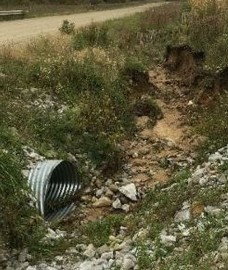
“The erosion was washing sand and rock straight into the river,” VandenBerg said.
Too much sediment in a river damages fish habitat by smothering spawning beds, reducing visibility and adding extra nutrients that can overgrow algae, sucking oxygen out of the water.
Soil erosion into Michigan’s streams is usually caused by infrastructure issues. Other causes of erosion are illegal recreational vehicle use, poor agricultural practices, poor forest management practices and certain activities by riverside homeowners.
Putting the data to work
VandenBerg and Smalligan added information on the eroded culvert to the RIVERS app and shared it with the Newaygo County Road Commission. The issue was fixed less than a week later. Their report protected fish habitat and helped fix the road infrastructure.
“Our goal is to minimize any negative effects on natural habitat while maintaining our network of county roads,” said Kelly Smith, Newaygo County Road Commission manager.
Trout Unlimited and the White River Watershed Partnership hope that Trout Unlimited chapters, watershed associations and other partners across the state will use RIVERS to catalog potential restoration projects and prioritize them when funding opportunities arise.
The RIVERS app is a convenient way for anglers and citizen scientists to collect information, helping turn everyday observations into actions that protect and improve Michigan’s waters. Every bit of information added in the RIVERS app helps Trout Unlimited and other conservation organizations better understand issues affecting streams and rivers.
Using the app
Trout Unlimited developed RIVERS training documents explaining how to download the app and start using it.
“The RIVERS app is easy to use and even works in areas with no cell reception,” Smalligan said.
For more information, contact Jacob Lemon at Trout Unlimited or Mike Smalligan at the DNR.
|